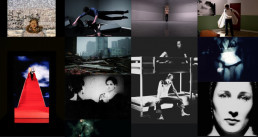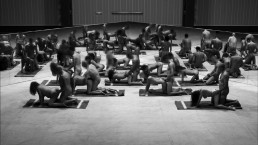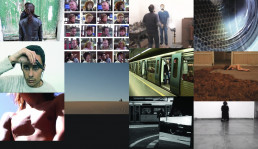1ª sessão – 29 Julho, 22h
Goethe Institut
Programa em parceria com VideoZone-4/CCA, Telavive
Com a presença de Sergio Edelsztein
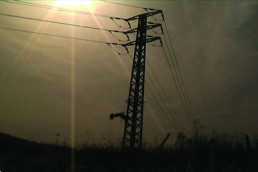
Tamar Ettun, Standing Prayer, 6’
Os movimentos das orações Judaicas em pé, são apresentadas pelo artista de pernas para o ar, literalmente virada ao contrário, pendurado em postes e diferentes estaleiros de construção em Israel, entre Jerusalém e Telavive. A música inspira-se numa melodia antiga cantada por Shlomo Fox, posteriormente acompanhado por um grupo e representa a procura individual por uma comunidade, identidade e rituais num ambiente contemporâneo.
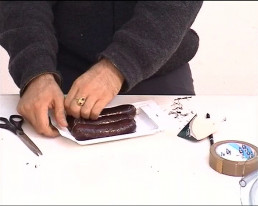
Lior Waterman, Boudin (2002), 12’
Uma série de experiências/experimentações nas quais o artista faz penetrar balões coloridos em salsichas de sangue francesas.
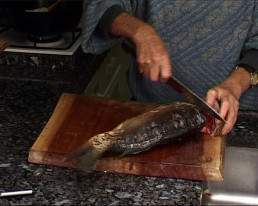
Boaz Arad, Gefilte Fish (2005), 12’
(peixe recheado – é um prato típico de cozinha judaica da Europa Oriental)
Este vídeo é um encontro entre uma mãe e um filho. Neste encontro, construído no formato de um programa culinário de televisão, a mãe ensina a receita de família de gefilte fish.
A cara da mãe não aparece no vídeo. Sempre que a câmara sobe até à cara, apareço eu no seu lugar.
A cabeça do peixe está sobre uma tábua de cozinha. A minha cabeça aparece num fundo semelhante, numa variação de comentador ou apresentador do programa. Durante o vídeo, ao mesmo tempo que aprendemos a receita, aprendemos algo sobre os Judeus Ashkenazi (Alemanha/Europa Central) e a sua relação com os Judeus Mizrachi (Norte de Africa e Médio Oriente), e o desaparecimento da cultura Ashkenazi.
A receita de peixe começa com a proibição de cozinhar no Sabbath. O prato pode ser comido frio, um dia depois de cozinhado. Na cultura Israelita, esta receita foi sendo desprezada, mesmo entre aqueles que nunca a provaram.
No meio do vídeo, o filho questiona-se sobre a perda das raízes familiares. Daí parte em círculos crescentes para a família, lar, comunidade, características israelitas e cultura ocidental.
O vídeo pode ser visto de diversos pontos de vista. O primeiro discute o aspeto político-social e o segundo tenta tocar algo pessoal, privado, numa criança que cresceu e agora surge como um adulto frente a sua (cujas mãos se empenham em afazeres violentos), tentando descodificar algo sobre a maternidade.
Em fundo, dois filmes de Alfred Hitchcock: Psycho, onde o personagem principal carrega a voz da mãe e The Birds (em Portugal Os Pássaros), no qual o pássaro pode ser visto como um sinal de um impulso primaveril, uma proibição que desenvolveu voz própria.
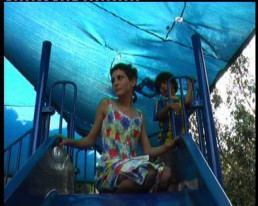
Malki Tesler, Playground (2008), 8’
Malki Tesler conquista um escorrega num parque infantil. Defeca em cima dele e recusa sair dali. O filme evolui essencialmente à volta das reações dos pais cujas brincadeiras dos filhos foram interrompidas. As reações desenvolvem-se em pré-violência, expondo a absurda gravidade com que os pais protegem os direitos sagrados dos seus filhos.
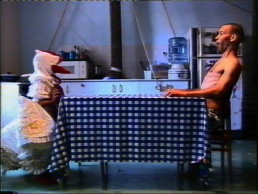
Guy Ben-Ner, Moby Dick (2000), 12’
Guy Ben-Ner recria a famosa história da caça à Baleia Branca na sua cozinha, desempenhando com a sua filha todos os personagens. O trabalho é apimentado com deixas de filmes antigos de Charlie Chaplin e Buster Keaton e citações de Body Art dos anos 70.
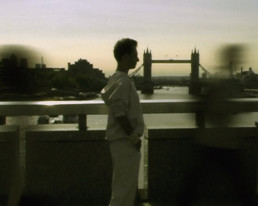
Ohad Fishof, A Slow Walk for Longplayer (2005), 7’
Na terça-feira, 21 de Junho de 2005, o dia mais longo do ano, Ohad Fishof à hora de ponta matinal, fez uma lenta caminhada num percurso definido, atravessando a London Bridge e voltando. A caminhada durou cerca de 9 horas, 43 minutos e 25 segundos até estar concluída.
A longa perambulação de Fishof marcou o quinto aniversário de Longplayer, uma composição musical com a duração de 1000 anos, criada por Jem Finer. Longplayer está programada para tocar continuamente e sem repetições desde 1 de Janeiro de 2000 até à sua conclusão em 31 de Dezembro de 2999.
O London Slow Walk marca o início de uma série de lentas caminhadas a serem realizadas por Ohad Fishof em grandes cidades internacionais.
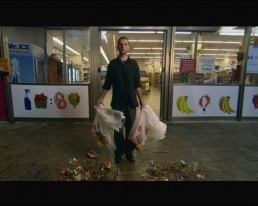
Doron Solomons, A Shopping Day (2006), 5’30’’
Em A Shopping Day (Um dia de compras), Doron Solomons utiliza a linguagem das indústrias da publicidade e do branding e o seu limitado léxico cinematográfico. Graças à linguagem e habilidade editoriais que utiliza, consegue subverter a mensagem e criar um drama a partir de uma tragédia pequena e quotidiana, revelando quão patético é ele próprio e a linguagem que utiliza. O suspense inicia-se com uma cena de compras, música dramática, trabalho de câmara e ângulos. Algo de trágico-dramático vai seguramente acontecer. Enquanto o próprio artista, o nosso habitual anti-herói de ar enigmático, sai do supermercado como objeto de uma tragédia anunciada, o saco de plástico rasga-se e as compras espalham-se e despedaçam-se ao ritmo usado pela publicidade para induzir os nossos desejos de consumo.
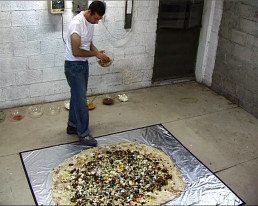
Shahar Markus, Sabich (2006), 4’35’’
Sabich é a comida de rua mais popular em Israel e tem a sua origem no Iraque. Os ingredientes deste prato são: ovos cozidos, beringelas, salada de vegetais, cebolas, pickles, molho picante e molho de manga.
No vídeo eu pinto um pão de pita com os ingredientes acima descritos, enquanto danço à volta da pita, numa forma que lembra uma cerimónia Indiana ou o trabalho artístico de Jackson Pollock.
A obra lida com materiais superiores e inferiores, com Arte superior e inferior e com a ligação entre cultura ocidental e oriental.
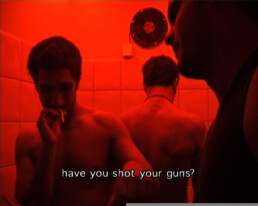
Ruti Sela & Maayan Amir, Beyond Guilt #1 (2003), 9’
A série Beyond Guilt aborda o minar da relação de poder entre fotógrafo e fotografado, homem e mulher, domínio público e esfera privada, objeto e sujeito. Os realizadores do filme, Sela e Amir desempenham um papel ativo no acontecimento. Por um lado, seduzem os entrevistados e por outro viram-lhes as câmaras, como parte do referido minar da relação de poder entre fotógrafo e sujeito.
A escolha de locais de filmagem como quartos de hotel ou casas de banho de bares de engate traduz-se num esforço para representar um submundo com as suas linguagens e significados próprios.
O breve encontro frente à câmara faz alusão à natureza efémera das relações íntimas, mas acima de tudo a obra faz alusão às influências da ocupação, do terror e do exército como fundadores de uma identidade Israelita até nos momentos mais íntimos. A identidade sexual e a identidade político-militar parecem inseparavelmente entrelaçadas.
1st session – July 29th, 10pm
Goethe Institut
Program in partnership with VideoZone-4/CCA, Tel Aviv
With the present of Sergio Edelsztein

Tamar Ettun, Standing Prayer, 6’
The movements of the Jewish standing prayer are performed by the artist upside down hanging from poles and different construction sites in Israel, between Jerusalem and Tel Aviv. The music is based on an ancient melody sang by Shlomo Fox and then joined by a group, and represents the search of one for a community, identity and rituals in a contemporary environment.

Lior Waterman, Boudin (2002), 12’
A series of experiments in which the artist penetrates colored balloons into French blood sausages.

Boaz Arad, Gefilte Fish (2005), 12’
The video is an encounter between a mother and a son. In this encounter, which is constructed in the format of a television cooking show, the mother teaches the family recipe for gefilte fish.
The mother’s face does not appear in the video. Every time the camera goes up to it, I appear, taking her place.
The fish’s head is laid on a cutting board. My head appears in a similar background, as a variation on the commentator or host of the show.
During the video, alongside learning the recipe, we learn something about the Ashkenazi (German/Eastern European) Jews, and their relation to the Mizrachi (North African and Middle Eastern) Jews, and about the disappearing Ashkenazi culture.
The fish’s recipe begins with a prohibition on cooking on Sabbath. The dish can be eaten cold, a day after cooking it. In Israeli culture, this recipe became contemptible, even among people who never tasted it.
In the center of the video – the son wonders about the lost family roots. From there he moves on in growing circles to family, home, community, Israeli characteristics and the western culture.
The video can be seen from several points of view. The first, discusses the social – political aspect, and the second, tries to touch something personal, privet, in a child who grew up and is now standing as an adult in front of his mother (whose hands engage in violent doings), trying to sort out something about motherhood.
In the background stand two films by Alfred Hitchcock: “Psycho”, in which the main character carries his mother’s voice, and “The Birds”, in which the bird can be seen as a sign for a primeval urge, a prohibition which developed a voice of its own.

Malki Tesler, Playground (2008), 8’
Malki Tesler conquers a slide in a children’s playground. She sits on it and refuses to move. The film evolves mainly around the reactions of the parents whose children’s play has been interrupted. The reactions develop into near-violence, exposing the absurd gravity by which parents protect their children’s sacred rights.

Guy Ben-Ner, Moby Dick (2000), 12’
Guy Ben-Ner recreates the famous story of the hunting of the White Whale in his kitchen, playing himself and his daughter all the characters. The work is spiced by quotes from early films of Chaplin and Keaton as well as quotes of the 1970’s Body Art.

Ohad Fishof, A Slow Walk for Longplayer (2005), 7’
On Tuesday 21 June 2005, the longest day of the year, Ohad Fishof led a very slow walk on a set route across London Bridge and back, beginning with the morning rush hour. The walk took 9 hours, 43 minutes and 25 seconds to complete.
Fishof’s lengthy perambulation marked the fifth anniversary of Longplayer, a 1000 years long musical composition created by Jem Finer. Longplayer is set to play continuously and without repetition from 1 January 2000 until its completion on 31 December 2999.
The London Slow Walk marked the beginning of a series of very slow walks to be performed by Ohad Fishof in major international cities.

Doron Solomons, Shopping Day (2006), 5’30’’
In A Shopping Day, Doron Solomons directly addresses the language of advertising and branding industries and its limited filmic lexicon. Using his editorial skill and editing language, he manages to subvert the message and create a drama of a daily and minor tragedy showing not only himself, but also this visual language, as pathetic. The buildup starts as a shopping sequence, with the dramatic music, the camera work and angles. Something dramatic is clearly going to happen. As the artist himself, our usual poker-faced anti-hero, stands outside the supermarket being the object of an announced tragedy of profusion and greed, the plastic bags tear open, and the goods are shattered and spilled in the same slow-motion shots used by the industry to induce our desire.

Shahar Markus, Sabich (2006), 4’35’’
The sabich is the most popular street food in Israel and originally it came from Iraq.
The ingredients of this dish are: boiled eggs, eggplants, vegetables salad, onions, pickles, hot red sauce and mango sauce.
In the video I am painting on the pita bread with the above food ingredients while I am dancing around the pita in a way that reminds an Indian ceremony or the artistic work of Jackson Pollock.
The work deals with high and low materials, High and low art and the connection between eastern and western culture.

Ruti Sela & Maayan Amir, Beyond Guilt #1 (2003), 9’
The series Beyond Guilt addresses the undermining of the power relation between photographer and photographed, men and women, the public domain and the private sphere, object and subject. As the film’s directors, Sela and Amir take an active part in the occurrence. They seduce the interviewees on the one hand, and turn the camera over to them, on the other, as part of the aforesaid undermining of power relations between photographer and subject.
The choice of pick-up bar services or hotel room as shooting locations strives to represent an underworld with its language and signifiers.
The quick encounter before the camera calls to mind the ephemeral nature of intimate relations, but most of all the works allude to the influences of the occupation, terror and army as constitutors of an Israeli identity even in the most private moments, the sexual identity and the military-political identity seem intertwined inseparably.

